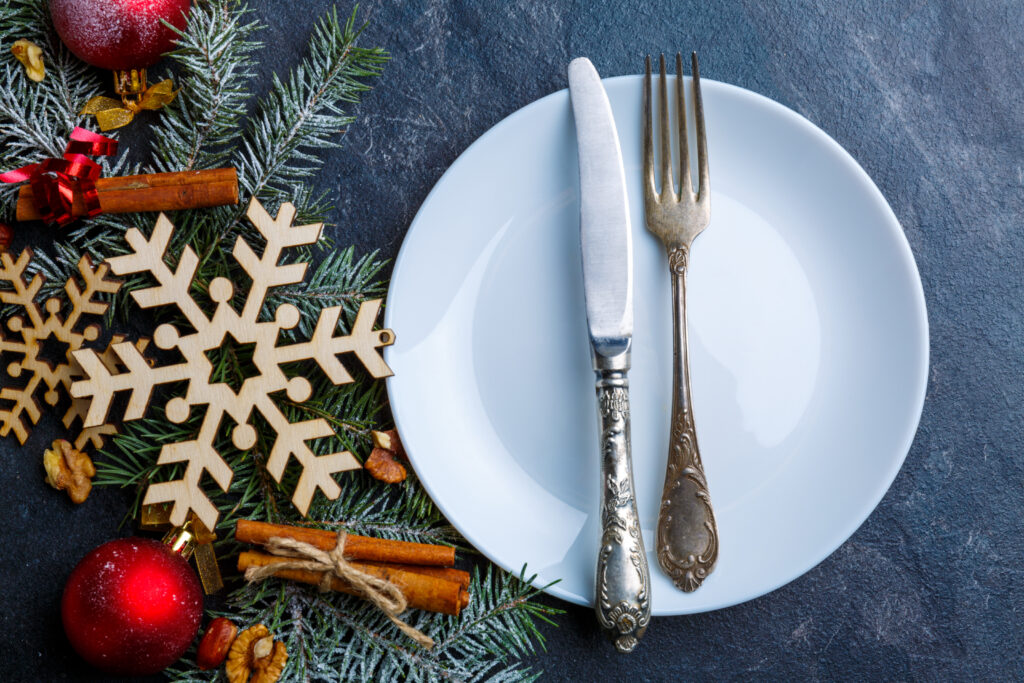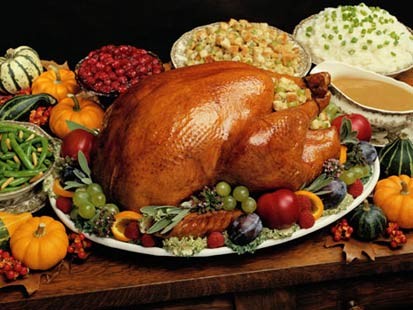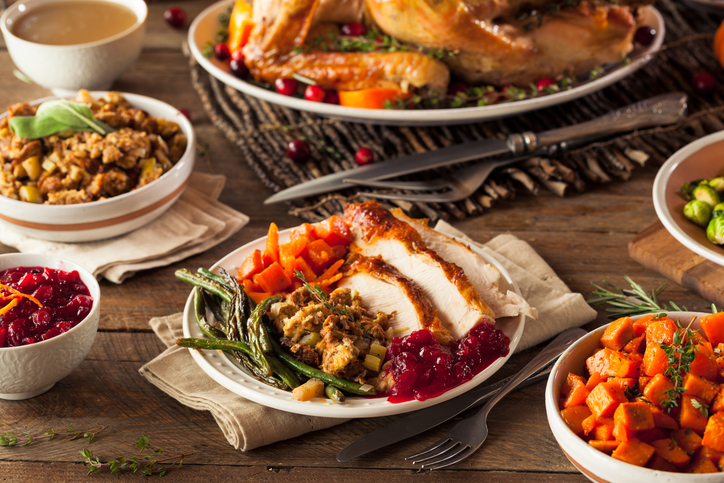
The Thanksgiving Turkey Top 10
Maureen Murphy, Manager of Consumer Trends, Nutrition & Lifestyles Thanksgiving is rapidly approaching! Here are the 10 most commonly asked questions consumers have when it comes to the holiday bird. When should I buy my turkey? If you’re purchasing a frozen turkey, you can do so at any time, but need to allow enough time for it to thaw. Check the sell-by date on a fresh turkey as it can be purchased and stored in the refrigerator up to that date on the label. It should be placed in the freezer if you plan to use after that date. What size turkey should I buy? Plan on approximately 1 lb. of turkey per person, which will allow for generous servings and leftovers. That being said, the larger the turkey, the greater the yield. A turkey larger than 16 lbs. will provide 2 servings/lb. i.e. a 20 lb. turkey will feed 40 people. How long can you keep a turkey in the freezer? As long as a turkey is kept in the freezer it will remain safe to eat indefinitely as food poisoning bacteria does not grow in the freezer, however for best quality it should be cooked within 1 year. How do I safely thaw my turkey? Thawing in the refrigerator is the preferred method of thawing. Estimate at least one day of thawing for every 4-5 pounds of turkey. A thawed turkey can remain in the refrigerator for 1 or 2 days before cooking. Although refrigerator thawing is preferred, don’t worry if you forgot to take the turkey out in enough time to thaw. You may also thaw the turkey in cold water or in the microwave if necessary. To thaw in cold water: Place the turkey breast-side down in its original wrapper in cold water to cover, and change the water every 30 minutes to keep the turkey surface cold. Minimum thawing time will be approximately 30 minutes per pound, and the turkey must be cooked immediately upon thawing. To thaw in the microwave: Check the manufacturer’s instructions for the size turkey that will fit in your microwave, recommended minutes per pound, and power level to use for thawing. The turkey must be cooked immediately once it is thawed. Is it safe to wash a turkey? It is not recommended that you wash a turkey! Any bacteria that may be present will be killed by cooking so there is no reason to wash it. You can actually run the risk of cross-contamination if you do wash the turkey as any loosely attached bacteria present can spread up to 2 feet around your kitchen. Bacteria could contaminate your dish towel, soap dispenser, etc. What’s the safe way to stuff a turkey?
The USDA’s Meat and Poultry Hotline actually recommends NOT stuffing the turkey. If it is stuffed, the stuffing may not reach the correct temperature of 165°F to kill bacteria even if the turkey itself reaches the safe minimum internal temperature of 165°F. Stuffing the turkey prolongs the cooking time and prohibits uniform cooking.
Here are some basic rules to follow if you do plan on stuffing the turkey:
Prepare stuffing just before it goes into the turkey. Dry ingredients can be mixed together and chilled ahead of time. Mix perishable (butter or margarine, mushrooms, sausage, oysters, broth, cooked celery and onions) ingredients however, just prior to placing stuffing inside the turkey and putting the turkey in the preheated oven. Stuffing should be moist, rather than dry, since heat destroys bacteria more rapidly in a wet environment
Stuff the cavity of the turkey loosely, about 3/4 cup stuffing per pound of turkey to allow the interior of the stuffing to reach the proper 165°F temperature in the center, and use a meat thermometer to ensure it has.
Remove the stuffing from the turkey as soon as it is completely cooled to prevent bacterial growth.
Can I cook a turkey ahead of time?
You can cook a turkey up to a couple days in advance if desired. Doing so is actually a great time saver and a way to maximize oven space on Thanksgiving Day. If you do cook it in advance, slice the meat off the bone, and refrigerate in shallow containers so it cools quickly. You can also collect the drippings and prepare your gravy ahead of time avoiding that last minute preparation. When it comes time to reheat the turkey: put in a shallow pan, sprinkle with broth or gravy, cover with foil, and place in a preheated 325°F oven for approximately 30 minutes or until it reaches the safe temperature of 165°F. You can cook it earlier Thanksgiving Day if you have the ability to hold it at 140°F or above, but it is not safe to cook it ahead of time and leave it at room temperature.
How long will my turkey take to cook? How can I tell when it’s done?
Most turkeys today come with pop-up timers, and they are generally accurate. If your turkey doesn’t come with one, it is recommended that a meat thermometer be used as it is the safest way to ensure that the turkey is done. The thermometer should be inserted into the inner most part of the breast/thigh area without touching bone. The turkey is done when the thermometer reaches a safe minimum internal temperature of 165°F. I like to use a meat thermometer even with a pop-up timer, not only for peace of mind so I know the turkey has reached 165°F, but also to check on how the turkey is progressing for timing of side dishes and serving.
The roasting chart below is only to be used as a guide.
TURKEY ROASTING CHART at 325°F
Weight (Pounds) Unstuffed (Hours)* Stuffed (Hours)*
8 – 12 2 ¾ – 3 3 – 3 ½
12 – 14 3 – 3 ¾ 3 ½ – 4
14 – 18 3 ¾ – 4 ¼ 4 – 4 ¼
18 – 20 4 ¼ – 4 ½ 4 ¼ – 4 ¾
20 – 24 4 ½ – 5 4 ¾ – 5 ¼
*Estimated cooking time
How do I travel with an uncooked and/or cooked turkey?
It is easiest to travel with a cold, uncooked turkey – put it in a cooler with ice so you know it is safe and cold when you reach your destination. If you need to bring a cooked turkey, it is safest to cook in advance. Slice the meat off the bone, refrigerate, and pack cold in a cooler with ice to travel, and then reheat at your destination. The only time you should transport a hot turkey is if you live very close to where you’ll be bringing the turkey. If you do, then take the turkey hot out of the oven, wrap in foil, newspapers and towels and place in a box to retain the heat. Be sure that where you are going has the oven on so you can pop the turkey back in as soon as you arrive so it stays at or above 140°.
How long will a cooked turkey keep?
Leftover turkey as well as any other holiday leftovers can be stored in the refrigerator for 3-4 days. If you don’t intend to eat by then, you can wrap the leftover turkey well and place in the freezer. Use within 2-6 months for best eating pleasure!
What’s the safe way to stuff a turkey?
The USDA’s Meat and Poultry Hotline actually recommends NOT stuffing the turkey. If it is stuffed, the stuffing may not reach the correct temperature of 165°F to kill bacteria even if the turkey itself reaches the safe minimum internal temperature of 165°F. Stuffing the turkey prolongs the cooking time and prohibits uniform cooking.
Here are some basic rules to follow if you do plan on stuffing the turkey:
Prepare stuffing just before it goes into the turkey. Dry ingredients can be mixed together and chilled ahead of time. Mix perishable (butter or margarine, mushrooms, sausage, oysters, broth, cooked celery and onions) ingredients however, just prior to placing stuffing inside the turkey and putting the turkey in the preheated oven. Stuffing should be moist, rather than dry, since heat destroys bacteria more rapidly in a wet environment
Stuff the cavity of the turkey loosely, about 3/4 cup stuffing per pound of turkey to allow the interior of the stuffing to reach the proper 165°F temperature in the center, and use a meat thermometer to ensure it has.
Remove the stuffing from the turkey as soon as it is completely cooled to prevent bacterial growth.
Can I cook a turkey ahead of time?
You can cook a turkey up to a couple days in advance if desired. Doing so is actually a great time saver and a way to maximize oven space on Thanksgiving Day. If you do cook it in advance, slice the meat off the bone, and refrigerate in shallow containers so it cools quickly. You can also collect the drippings and prepare your gravy ahead of time avoiding that last minute preparation. When it comes time to reheat the turkey: put in a shallow pan, sprinkle with broth or gravy, cover with foil, and place in a preheated 325°F oven for approximately 30 minutes or until it reaches the safe temperature of 165°F. You can cook it earlier Thanksgiving Day if you have the ability to hold it at 140°F or above, but it is not safe to cook it ahead of time and leave it at room temperature.
How long will my turkey take to cook? How can I tell when it’s done?
Most turkeys today come with pop-up timers, and they are generally accurate. If your turkey doesn’t come with one, it is recommended that a meat thermometer be used as it is the safest way to ensure that the turkey is done. The thermometer should be inserted into the inner most part of the breast/thigh area without touching bone. The turkey is done when the thermometer reaches a safe minimum internal temperature of 165°F. I like to use a meat thermometer even with a pop-up timer, not only for peace of mind so I know the turkey has reached 165°F, but also to check on how the turkey is progressing for timing of side dishes and serving.
The roasting chart below is only to be used as a guide.
TURKEY ROASTING CHART at 325°F
Weight (Pounds) Unstuffed (Hours)* Stuffed (Hours)*
8 – 12 2 ¾ – 3 3 – 3 ½
12 – 14 3 – 3 ¾ 3 ½ – 4
14 – 18 3 ¾ – 4 ¼ 4 – 4 ¼
18 – 20 4 ¼ – 4 ½ 4 ¼ – 4 ¾
20 – 24 4 ½ – 5 4 ¾ – 5 ¼
*Estimated cooking time
How do I travel with an uncooked and/or cooked turkey?
It is easiest to travel with a cold, uncooked turkey – put it in a cooler with ice so you know it is safe and cold when you reach your destination. If you need to bring a cooked turkey, it is safest to cook in advance. Slice the meat off the bone, refrigerate, and pack cold in a cooler with ice to travel, and then reheat at your destination. The only time you should transport a hot turkey is if you live very close to where you’ll be bringing the turkey. If you do, then take the turkey hot out of the oven, wrap in foil, newspapers and towels and place in a box to retain the heat. Be sure that where you are going has the oven on so you can pop the turkey back in as soon as you arrive so it stays at or above 140°.
How long will a cooked turkey keep?
Leftover turkey as well as any other holiday leftovers can be stored in the refrigerator for 3-4 days. If you don’t intend to eat by then, you can wrap the leftover turkey well and place in the freezer. Use within 2-6 months for best eating pleasure!





















